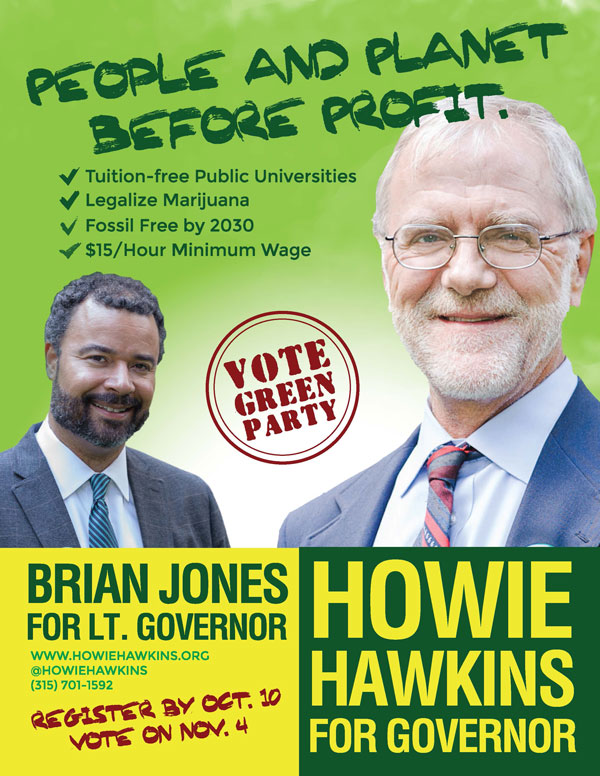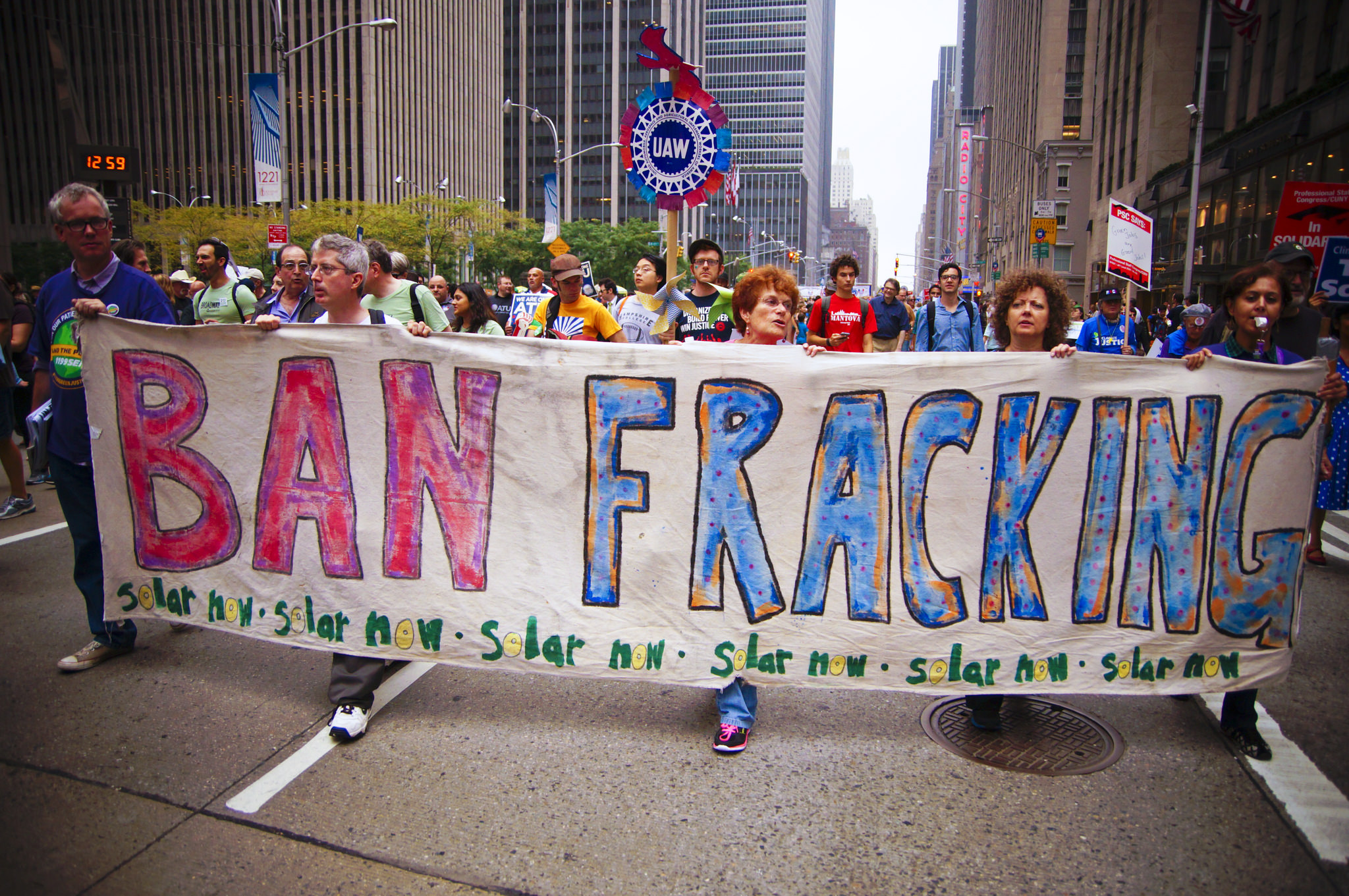Howie Hawkins
October 29, 2017
Howie Hawkins is the Green Party Candidate for Mayor of Syracuse NY. For information about his campaign, visit his website.
Stephanie Luce asks why did Cuomo shift leftward after the 2014 gubernatorial election in New York? Her answer is that progressives working inside the Democratic Party – Working Families Party, Zephyr Teachout, Bernie Sanders, Fight for $15 demos organized by Democratic Party-oriented unions – changed the political landscape and forced Cuomo to move left to recover the left wing of his electoral base.
Luce’s analysis misses the role of the independent left and the votes Cuomo lost to the Green Party in 2014. In 2014 I ran for Governor of New York with the teacher and socialist activist, Brian Jones, as my Lt. Governor running mate. Our ticket received 5% of the vote in the general election (185,419), which was about the same number of votes (192,210) as Zephyr Teachout’s 33% vote in the Democratic primary. The Green vote jumped the Green Party past the Working Families and Independence parties on all state ballots, which list parties in order of their votes for the gubernatorial ticket.

The votes for candidates to Cuomo’s left in both the primary and general elections mattered to him. The 5% Green vote was the most for an independent left party ticket for Governor/Lt. Governor in New York history except for the 6% received by the Socialist tickets in 1918 and 1920. It was widely reported when Cuomo started his 2014 campaign that he hoped to surpass his father Mario’s best win of 66% in 1986 and use that result as a launching pad for a presidential bid. Instead, Cuomo’s 54% in 2014 was way down from his 63% in 2010 and well below all winning Democrats in modern New York history. He knows he lost most of those votes to his left.
The Greens don’t claim sole credit for Cuomo adopting policies that he opposed, or would not commit to, when the Green ticket campaigned for them in both 2010 and 2014. Those policies include not only the fracking ban, $15 minimum wage, tuition-free public universities, and paid family leave that Luce mentions, but also funding a state plan for 100% renewable energy by 2030, Raise the Age (i.e., end the prosecution 16 and 17 year-olds as adults), a ban on solitary for incarcerated minors, and making New York a sanctuary state.
Greens give the reform Democrats their due. We acknowledge that Cuomo felt and feels their pressure. But they should give the independent left its due as well, especially when, according to Luce, the WFP is trying to rebuild trust with progressives who were so dismayed at WFP’s nomination of Cuomo. That trust-building has certainly not been extended to the Greens. WFP is making no attempt to build positive working relationships with the left that is independent of the corporate-financed Democrats. Rather, they work to keep the independent left out of the decision-making and the speakers’ platforms in coalitions they influence.
A Missed Opportunity for Cooperation
As the 2014 gubernatorial campaign got under way, many WFP supporters, including state committee members, urged me to seek the WFP as well as Green nominations. They could not stand the thought of WFP endorsing Cuomo again. Fusion – being nominated and appearing on the ballot of more than one party – is legal and common in New York State. It takes 50,000 votes for the gubernatorial ticket to create a ballot line party for the next four years. Of the eight parties now with ballot status, only the Green Party line was created by running a candidate who was not also the candidate of the Democrats or Republicans. The other five “minor” parties routinely cross-endorse the “major” party with which they are aligned.
Green Party rules in New York preclude fusion with the corporate parties and their satellites like WFP.
But given the many appeals from WFP supporters in 2014, I wrote a letter to the WFP co-chairs in April asking for a meeting to discuss how we might work together to oppose Cuomo and his conservative economic agenda in the 2014 elections. In the meantime, I drafted a Green Party rules change that if adopted would have allowed fusion with WFP on a case-by-case basis for a two-year trial period if WFP was willing to run a joint ticket against Cuomo and run more progressive independents against corporate Democrats. I never received a response to my letter and the rule change was not proposed at the Green nominating convention.
WFP Supports a Conservative Democrat Against a Green
The rule change I drafted was certainly controversial within the Green Party because of bad experiences with WFP and its endorsed Democrats. In my own case in two-way city council races in 2011 and 2013 where I was running against a Democrat, WFP brought in their upstate and downstate political directors to coordinate paid campaign workers to canvass and get out the vote in order to defeat me. In 2011, I received 48% of the vote, losing by just 96 votes. In office, my Democratic Party opponent, Khalid Bey, was known for spearheading tax breaks for developers, slow walking and weakening ordinances to Ban the Box and hire more city residents on city contracts, towing Cuomo’s line against increased state revenue sharing for high-poverty fiscally-strapped cities like Syracuse, and being the only city councilor to vote against extending non-discrimination protection to transgender people in the wake of a hate crime murder of a transgender woman.
In 2013, WFP’s second invasion of my council district – there is no WFP organization in the district or the city – prompted a petition by labor and socialist activists around the state asking the WFP to stop campaigning against me in favor of a centrist Democrat.
WFP defenders often dismiss the Green Party as more interested in political posturing than political power. Although Greens are critical of the strategies of reform Democrats, Greens do work with progressive Democrats for policy reforms in coalitions where decision-making and speaking platforms are shared across the Green/Democratic party divide. While WFP has not been a willing ally of the Greens, we have many Democratic allies we work with on issue campaigns. Just two examples: Green party activists have worked with Democratic Senator Richard Gottfried, principal sponsor of New York’s single-payer health care bill and with members of the New York Assembly to include in the state budget funding to plan for 100% clean energy by 2030.
NY Greens Lever the Political Landscape Left
By remaining independent and raising movement demands without dilution, Greens have been able to lever the political landscape to the left, including WFP positions, on some issues. It was the elected Greens of New Paltz, Mayor Jason West and Deputy Mayor Rebecca Rotzler, who got the marriage equality movement going in New York in 2005 by performing two dozen gay marriages in defiance of objections from Democratic-oriented LGBT groups and until a court injunction secured by the Democratic State Attorney General, Elliot Spitzer. By 2011, the marriage equality was New York law. In my 2010 gubernatorial campaign, I called for a state bank, which got a good response in the wake of the 2008 financial crash and foreclosure crisis. After the election, WFP’s policy shop, the Center for Working Families, produced policy papers on public banking and sought state legislative sponsors for a state bank bill.
In 2009 and 2010 the environmental movement was debating whether natural gas was a “bridge to renewables” or whether a moratorium on fracking while it was studied was in order. In contrast, the Green Party campaigned for a ban on fracking.

The demand for an immediate ban came from the grassroots movement, from Greens, other environmentalists, home owners, farmers – Democratic, Republican, and independent – in the southern tier of New York, which was ground zero for potential fracking wells. One of the grassroots leaders was a Green elected to the town board of Afton, Mary Jo Long. I took that demand into the 2010 gubernatorial campaign and it caught fire. The environmental movement in New York abandoned the natural gas “bridge” and the ban replaced the moratorium demand. WFP, which had been circulating moratorium petitions before the election, began circulating ban petitions after the election.
WFP, through the Working Families Organization, the 501c4 organizational and money power behind the party organization shell, and other liberal Democratic groups and funders, moved in to create the New Yorkers Against Fracking that Luce mentions. Unfortunately, NYAF too often gave Greens the usual run arounds when it came to seats at the decision-making tables and speakers at demonstrations and news conferences. “The Greens are political and it will jeopardize our non-profit status.” When a Democratic politician was scheduled to speak, we were told, “That’s different. They’re elected.” When we offered our own elected officials, we were told our electeds were “only” municipal officials. The grassroots movements in the southern tier were similarly marginalized as the funded and staffed group grabbed the media spotlight. NYAF’s constant activities and dogging of Cuomo were no doubt important in the governor ultimately accepting the ban recommendation from his health commissioner. But NYAF’s organizing style did not always build trust with organizers in the grassroots movement.
Cuomo’s gestures to his left have not changed his core conservative program. Luce identifies areas where he remains terrible, from inadequate and inequitable school funding and the test-punish-and-privatize school reform agenda to corporate tax cuts and his New Year’s Eve veto of full funding for public defenders. To this we must add and emphasize the Wall Street- and real estate-friendly reactionary core of Cuomo’s policy agenda: tax and budget policies that impose austerity on upstate cities, counties, and towns while doling out tax breaks and grants as a corporate patronage system.
Greens Are Not Afraid to be Anti-Imperialist
We must also note that WFP, and reform Democrats like Teachout and Sanders generally, avoid raising anti-imperialist foreign and military policy demands, which have enormous consequences for domestic policies that affect working people. For example, during the 2014 gubernatorial campaign, Cuomo travelled to Israel where he met with Israeli Prime Minister Benjamin Netanyahu and declared his support for Israel’s military campaign in Gaza. As Cuomo’s primary opponent, Teachout refused in several media queries to take a position on Israel’s Gaza campaign or Cuomo’s Israel visit. She did say she opposed BDS and that she wanted the U.S. to maintain its “special relationship” with Israel. The Hawkins-Jones campaign, by contrast, denounced Israel’s military campaign in Gaza when it started and then Cuomo’s trip to Israel to support it.
We need an independent left that is free to raise issues that those caught inside the Democratic Party power structure will not raise, because they fear becoming marginalized. That power structure is organized around entrepreneurial candidate organizations that seek investments from big donors. The big donors call the shots in the end.
While I urge progressives inside the Democratic Party to leave and help build a powerful independent left, I also urge those that remain to see the independent left as their allies, not their competitors. The stronger the independent left is, the more leverage progressives inside the Democratic Party will have. Unfortunately, the WFP exemplifies a sectarian trend among many progressive Democrats whose narratives simply erase the independent left and whose practice often fights that independent left more than it fights the right.
Howie Hawkins is a Teamster working at UPS in Syracuse, New York where he is running for Mayor.
